Donnie created a model to investigate what happens to icebergs in water. He placed an ice cube in a tray of water, as shown in the following illustration. Donnie observed that the ice cube slowly melted. What can Donnie conclude from this observation?
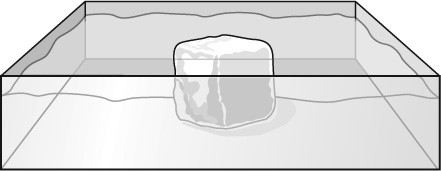
A. The water has a lower temperature than the ice cube.
B. The water has a higher temperature than the ice cube.
C. The water has a lower specific heat capacity than the ice cube.
D. The water has a higher specific heat capacity than the ice cube.
B. The water has a higher temperature than the ice cube.
There are several major global wind systems on Earth. Which term describes tropical winds that blow from east to west?
A. easterlies
B. westerlies
C. jet streams
D. trade winds
D. trade winds
Air quality is a measure of how clean or polluted the air is. Which of the following is a common way to determine air quality?
A. measuring the temperature of the air
B. measuring the amount of oxygen in the air
C. measuring the amount of ground-level ozone
D. measuring the number of air-related health issues people have
C. measuring the amount of ground-level ozone
An astronomer studying planets outside our solar system has analyzed the atmospheres of four planets. Which of these planets’ atmospheres would be most able to support a colony of humans?
A. Planet A: 76% Nitrogen, 23% Oxygen, 1% Other
B. Planet B: 82% Nitrogen, 11% Oxygen, 7% Other
C. Planet C: 78% Nitrogen, 1% Oxygen, 21% Other
D. Planet D: 27% Nitrogen, 3% Oxygen, 70% Other
A. Planet A: 76% Nitrogen, 23% Oxygen, 1% Other
Earth receives energy from the sun. Which of the following forms of electromagnetic radiation is the main form in which electromagnetic radiation from the sun reaches Earth’s surface?
A. visible light
B. radio waves
C. gamma rays
D. ultraviolet light
A. visible light
The following illustration shows a valley between two mountains. The arrows indicate direction of air movement.
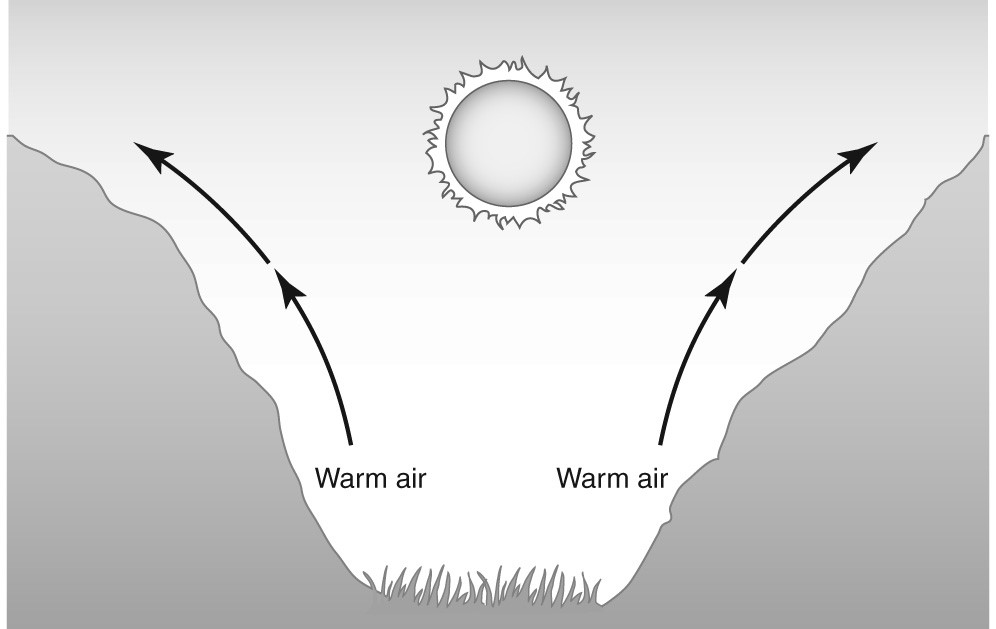
Which type of breeze is illustrated in the figure?
A. a sea breeze
B. a land breeze
C. a valley breeze
D. a mountain breeze
C. a valley breeze
Smog is a pollutant that can cause serious health problems. Smog is most often seen over large cities. Which of these substances is a main ingredient of smog?
A. volcanic ash
B. vehicle exhaust
C. carbon dioxide
D. acidic precipitation
B. vehicle exhaust
The picture below shows all three methods of energy transfer.
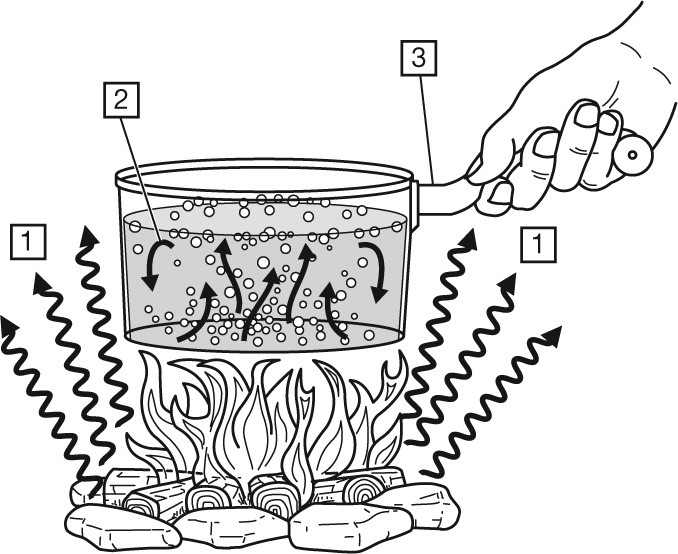
Which of these correctly identifies the three methods of energy transfer?
A. 1: convection 2: radiation 3: conduction
B. 1: radiation 2: conduction 3: convection
C. 1: conduction 2: convection 3: radiation
D. 1: radiation 2: convection 3: conduction
D. 1: radiation 2: convection 3: conduction
Which of the following is an example of conduction?
A. Warm air in the atmosphere rises.
B. Solar energy warms rock on Earth’s surface.
C. Cool ocean water sinks below warm ocean water.
D. Magma warms rock with which it comes in contact.
D. Magma warms rock with which it comes in contact.
The Coriolis effect is the curving of the path of a moving object. How does the Coriolis effect influence the wind?
A. It causes the air to move.
B. It changes the direction of the wind.
C. It causes winds to move in straight paths.
D. It changes the height at which wind travels.
B. It changes the direction of the wind.
Which of the following best describes the atmosphere?
A. the boundary between Earth’s surface and outer space
B. the boundary between the thermosphere and outer space
C. the boundary between Earth’s surface and the troposphere
D. the boundary between the troposphere and the ozone layer
A. the boundary between Earth’s surface and outer space
The ozone hole is actually an area of depleted ozone in Earth’s atmosphere. Which of the following human activities has been the greatest contributor to the development of the ozone hole?
A. the increase in factory emissions
B. the use of oil in automobile engines
C. the use of airplanes in the atmosphere
D. the use of chlorofluorocarbons in refrigeration
D. the use of chlorofluorocarbons in refrigeration
Refer to the diagram of winds and currents below to answer the question.
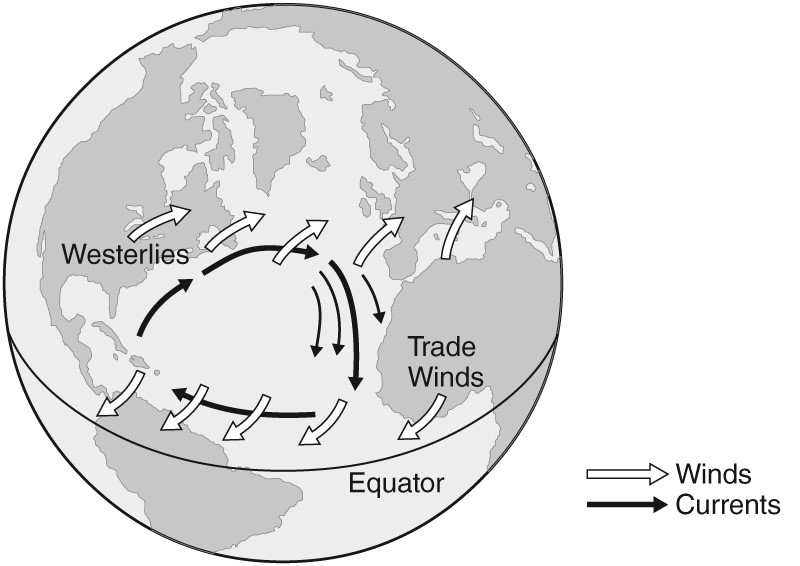
Which of the following best explains the curvature of the arrows for the westerlies and the trade winds?
A. The ocean currents create winds flowing in a similar direction to the current.
B. The Coriolis effect causes the winds to curve that way because the Earth rotates from left to right.
C. The Coriolis effect causes the winds to curve that way because the Earth rotates from right to left.
D. The sun is shining and warming the air from the right side of this diagram.
B. The Coriolis effect causes the winds to curve that way because the Earth rotates from left to right.
The wind in a certain area is blowing from east to west. Which of the following conclusions is most justified by this fact?
A. The west is experiencing lower air pressure than the east.
B. The west is experiencing higher air pressure than the east.
C. The west is experiencing lower air temperature than the east.
D. The west is experiencing higher air temperature than the east.
A. The west is experiencing lower air pressure than the east.
The following diagram shows the four layers of the atmosphere.
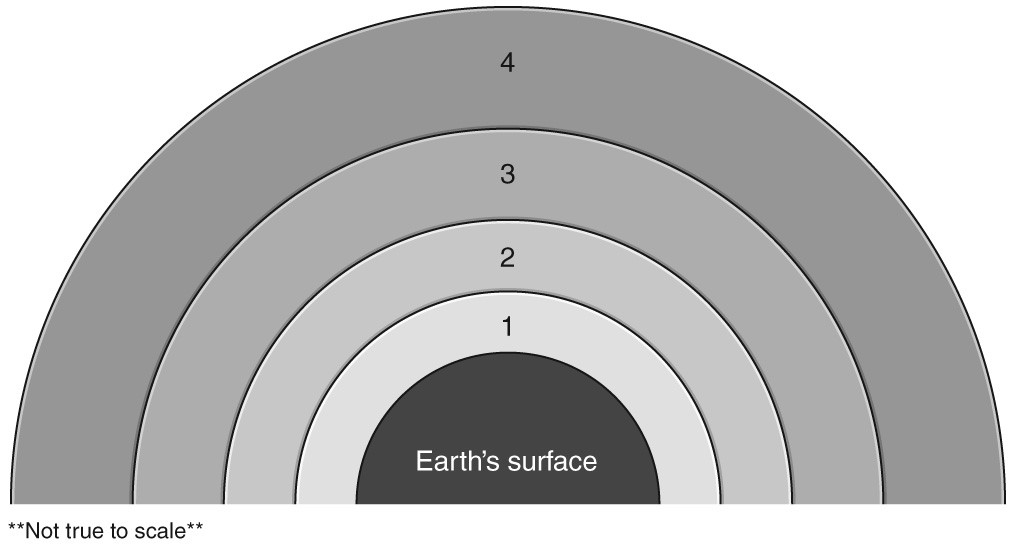
Which layer is responsible for shielding Earth from ultraviolet radiation?
A. layer 1
B. layer 2
C. layer 3
D. layer 4
B. layer 2
There are many sources of air pollution in the United States and around the world. Some are natural sources, and others come from humans. Which of these examples is a human source of air pollution?
A. dust storms
B. volcanic ash
C. industrial emissions
D. forest fires caused by lightning
C. industrial emissions
Explain why convection happens more efficiently in water or air than it does in rock.
-understanding of what convection is (e.g., Convection is the transfer of energy by moving particles; etc.)
-understanding of the differences in particle motion in rock (solid), water (liquid), and air (gas); (e.g., In water or air, particles move more freely than in rock. The freedom of movement results in more efficient transfer of energy; etc.)
The layer of gases that surrounds Earth is called the atmosphere. Earth’s gravity keeps the atmosphere from dispersing into space. Refer to the following circle graph.
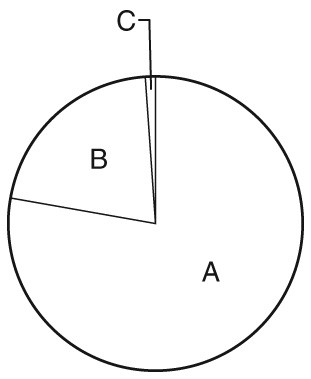
The graph shows the relative abundance of gases in Earth’s atmosphere. Which gas(es) correspond(s) to label C in the figure?
A. oxygen
B. nitrogen
C. argon and carbon dioxide
D. oxygen and carbon dioxide
C. argon and carbon dioxide
The specific heat capacity of water is higher than the specific heat capacity of land. Explain how this difference affects air temperatures along a coastline during a hot summer.
-understanding of the concept of specific heat capacity (e.g., Water has a higher specific heat capacity than land; etc.)
-understanding of the effects of specific heat capacity on the ability of water and land to absorb energy (e.g., The ocean can absorb more energy without a significant rise in temperature than the land can; etc.)
-understanding that air above land is warmer than air over ocean water (e.g., Along a coastline, if the land and the ocean water receive the same amount of energy in the form of heat, the land warms faster than the ocean. The air above the land also warms faster than air above the water warms; etc.)
-how the process of convection applies to the scenario (e.g., Convection will cause cool air from above the ocean to move over the land; etc.)
Exposure to air pollutants can cause serious health issues. Some humans take precautions, such as the person in the picture below.
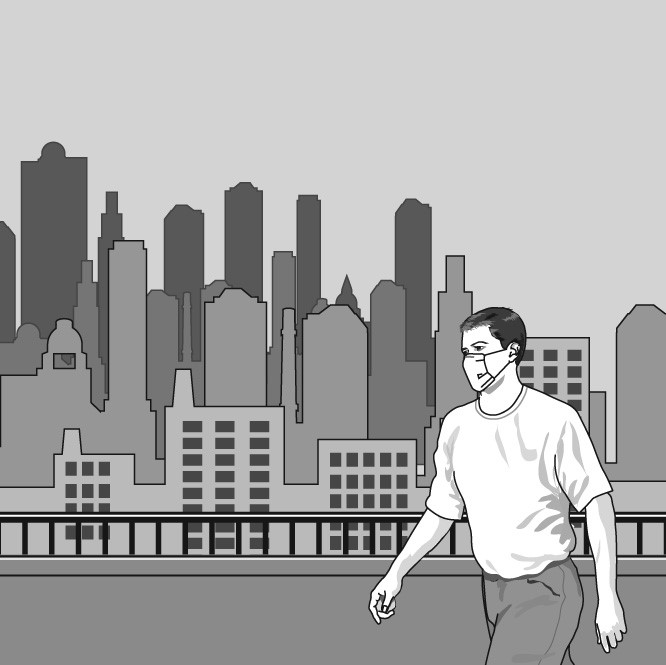
Which of the following is a short-term health problem that the person in the picture is most likely trying to avoid?
A. blurred eyesight
B. lung cancer
C. skin cancer
D. throat irritation
D. throat irritation